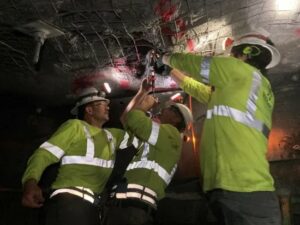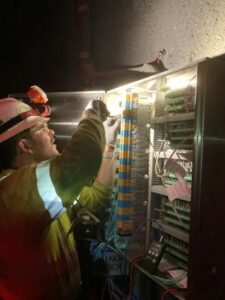Precision in Depths: How RESPEC’s Instrumentation Team Helped Thyssen Mining Succeed
How do you safely excavate a hard-rock cavern that’s 600 feet long and 90 feet tall and wide 4,850 feet below the surface? Our client, Thyssen Mining (Thyssen), needed answers before delivering on SURF’s expectations. Thyssen knew the risks at play. Safety, man hours, capital, and their reputation, along with industry hurdles, and today’s deadline always on the horizon. The risk was real, but the answer was simple: succeed.
 Thyssen had the people, equipment, and expertise to get their job done, but they would need more. ARUP designed constraints, but Thyssen had to stay within the model in the real world. In other words, they needed to translate real-world mining effects into concrete numbers that could be compared to developed models in real-time.
Thyssen had the people, equipment, and expertise to get their job done, but they would need more. ARUP designed constraints, but Thyssen had to stay within the model in the real world. In other words, they needed to translate real-world mining effects into concrete numbers that could be compared to developed models in real-time.
Instrumentation collects raw data, but specialists are needed to produce relevant information. The project scale was massive, the variables unknown, and the logistics challenging. With tight margins and high risks, Thyssen couldn’t afford inferior results. Instead, they sought to position themselves for success by finding highly experienced specialists.
RESPEC’s instrumentation team, led by Eric Krantz and comprised of John Knight, Eli Olson, Koby Dobler, Nick Marnach, and Dr. Evan Keffeler, surpassed Thyssen’s expectations. Eric brought 20 years of experience with instrumentation, using data loggers in various industries, including mining and structural movement detection. Data loggers monitor any environmental signal, from wind speed to a crack in the rock, and convert them into numbers for multiple outputs and controls, proving helpful for Thyssen’s objective.
The instrumentation group had to design, develop, install, and maintain a robust and reliable system. The instruments needed to sift through raw data to output relevant excavation conditions as a dashboard. The purpose was bird-eye observation when the rocks moved beyond safe parameters. The team developed and installed multi-point borehole extensometers in the ribs and in the ceiling and in-place inclinometers.
Extensometers anchor at the back of a 50-foot-deep hole, with a rod extending into a sensor reading lateral movement. Inclinometers, placed every five feet, gauge tilt with high precision, providing measurement resolutions to hundredths of a millimeter (e.g., a grain of sand). Combined, these instruments issue raw, real-time data during excavation.
 The excavation model was phased, dictating the expected reaction to digging and blasting. Whenever construction reached a new phase, a new area, or a new method of excavation the extensometers and inclinometers also required their limits tailored to ensure that forces weren’t exceeded. The limits were adjusted to prevent construction delays through false alarms on the customized dashboard.
The excavation model was phased, dictating the expected reaction to digging and blasting. Whenever construction reached a new phase, a new area, or a new method of excavation the extensometers and inclinometers also required their limits tailored to ensure that forces weren’t exceeded. The limits were adjusted to prevent construction delays through false alarms on the customized dashboard.
ARUP’s modeling predictions proved accurate, and Thyssen followed metrics and the dashboard produced by RESPEC. In doing so, Thyssen controlled their outcome with outstanding results for SURF, completing the project successfully without missing any alarming situation.
Though the project was completed successfully, it wasn’t without hiccups. RESPEC made major modifications to the equipment and ensured the instrumentation survived blasting. Not an easy feat when tons of stone explode into rock shrapnel the size of golf balls launched at 800 mph. The team made alterations off-site, ensuring the equipment worked upon installation. They proactively reduced time wasted and provided high-quality service, anticipating and optimizing the client’s flow.
With previous experience in mines, Eric and team members worked to anticipate needs. For instance, owing to equipment or drilling failures, notice for installation was sometimes less than 24 hours. The team maintained flexibility to meet our client’s needs and were often there the next day.
 They also developed redundant tools and equipment in case of blasting failure or for immediate installation. Our specialists manufactured hard tooling to test holes after drilling to verify hole quality requirements and doing so saved Thyssen time on installation requests when the hole was otherwise improperly prepared. If all else failed, our team also fabricated a muck scoop in case something was missed. Overall, the team’s concerted efforts reduced logistical overburden and increased Thyssen Mining and RESPEC throughput.
They also developed redundant tools and equipment in case of blasting failure or for immediate installation. Our specialists manufactured hard tooling to test holes after drilling to verify hole quality requirements and doing so saved Thyssen time on installation requests when the hole was otherwise improperly prepared. If all else failed, our team also fabricated a muck scoop in case something was missed. Overall, the team’s concerted efforts reduced logistical overburden and increased Thyssen Mining and RESPEC throughput.
After two and a half years, Eric and the team remain forward-thinking, recognizing the opportunity to maintain continuity with Thyssen and future work with the SDSTA during their next build-out phase. They are better armed with specific experiences and logistical details, learning from past projects to streamline cooperation.
“It’s all about meeting with a client, responding to their needs, and developing that relationship,” says Eric.

Stay in Touch